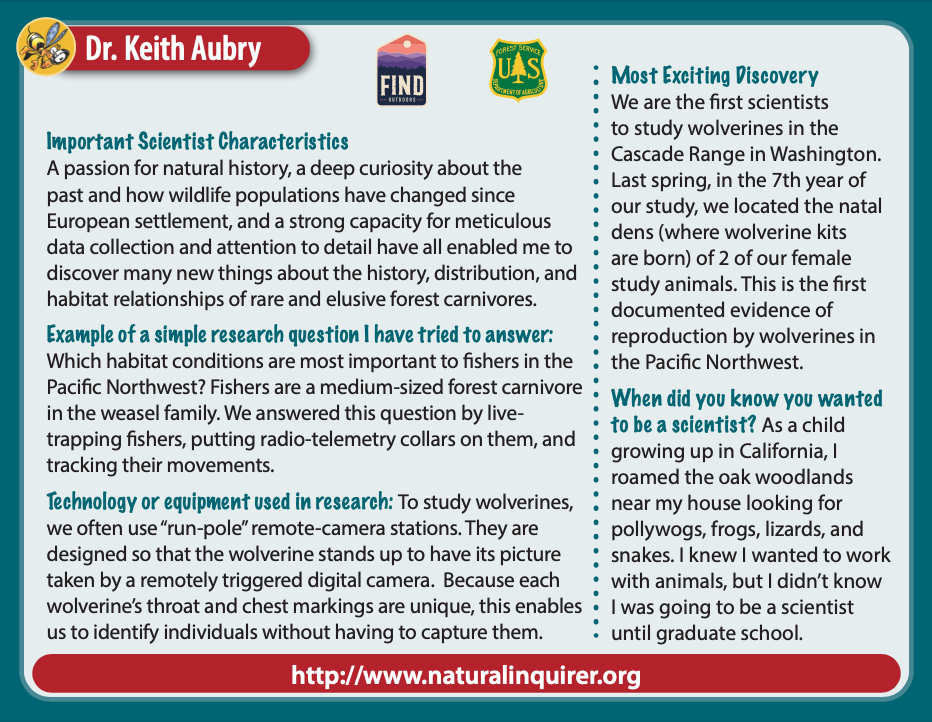Explore & Download All Collector Cards
Browse our ever-growing list of collector cards featuring a huge variety of careers in the Forest Service. Download and print collector cards and posters for free.

-

 FireInsectsWildlife
FireInsectsWildlifeBrian E. Dickerson, Wildlife Biologist

- M.S., Texas State University
- USDA Forest Service Scientist
- A wildlife biologist studies wild animals in their habitats. A wildlife biologist applies this knowledge to maintain populations of wild animals for future generations.
- M.S., Texas State University
- USDA Forest Service Scientist
- A wildlife biologist studies wild animals in their habitats. A wildlife biologist applies this knowledge to maintain populations of wild animals for future generations.
-

 Wildlife
WildlifeChris Colt, Wildlife Biologist

- M.S., University of Nebraska
- USDA Forest Service Scientist
- As a wildlife biologist, I study wildlife and how they interact with the ecosystem. I monitor animal populations and habitats, and I organize projects to improve habitat.
- M.S., University of Nebraska
- USDA Forest Service Scientist
- As a wildlife biologist, I study wildlife and how they interact with the ecosystem. I monitor animal populations and habitats, and I organize projects to improve habitat.
-

 Forests & PlantsWaterWildlife
Forests & PlantsWaterWildlifeTim Baldwin, Herpetologist

- Ph.D., Alabama A&M University
- USDA Forest Service Scientist
- A herpetologist studies reptiles and amphibians. I assess how reptile and amphibian populations respond to forest management and land-use changes.
- Ph.D., Alabama A&M University
- USDA Forest Service Scientist
- A herpetologist studies reptiles and amphibians. I assess how reptile and amphibian populations respond to forest management and land-use changes.
-

 Wildlife
WildlifeKeith Aubry, Wildlife Biologist

- Ph.D., University of Washington
- USDA Forest Service Scientist
- A wildlife biologist studies terrestrial wildlife species (mammals, birds, reptiles, and amphibians) and the habitats they occupy to better understand their biology and habitat relationships.
- Ph.D., University of Washington
- USDA Forest Service Scientist
- A wildlife biologist studies terrestrial wildlife species (mammals, birds, reptiles, and amphibians) and the habitats they occupy to better understand their biology and habitat relationships.
-

 Forests & PlantsInsectsWildlife
Forests & PlantsInsectsWildlifeWayne J. Arendt, Research Ornithologist

- Ph.D., University of Wisconsin-Madison
- USDA Forest Service Scientist
- I study disturbance ecology, climate change, conservation and management of Neotropical resident and migratory bird communities, and invasive species.
- Ph.D., University of Wisconsin-Madison
- USDA Forest Service Scientist
- I study disturbance ecology, climate change, conservation and management of Neotropical resident and migratory bird communities, and invasive species.
-

 Wildlife
WildlifeSybill K. Amelon, Wildlife Ecologist

- Ph.D., Missouri-Columbia
- USDA Forest Service Scientist
- A wildlife ecologist studies native animal species at multiple levels of biological organization, from genetics of wildlife populations to interactions of wildlife ecosystem processes.
- Ph.D., Missouri-Columbia
- USDA Forest Service Scientist
- A wildlife ecologist studies native animal species at multiple levels of biological organization, from genetics of wildlife populations to interactions of wildlife ecosystem processes.
-


-


-

 Artemis Moon Trees
Artemis Moon TreesCradle of Forestry Moon Tree

- American sycamore (Platanus occidentalis)
- This first-generation Moon Tree can be visited at the Cradle of Forestry, in Pisgah Forest, North Carolina, the birthplace of forestry and forestry education in the United States.
- American sycamore (Platanus occidentalis)
- This first-generation Moon Tree can be visited at the Cradle of Forestry, in Pisgah Forest, North Carolina, the birthplace of forestry and forestry education in the United States.
-

 Artemis Moon Trees
Artemis Moon TreesTell City Moon Trees

- Sweetgum (Liquidambar styraciflua)
- These first-generation Moon Trees are located in Tell City, Indiana. First-generation Moon Trees were grown from seeds that orbited the Moon on Apollo 14.
- Sweetgum (Liquidambar styraciflua)
- These first-generation Moon Trees are located in Tell City, Indiana. First-generation Moon Trees were grown from seeds that orbited the Moon on Apollo 14.



